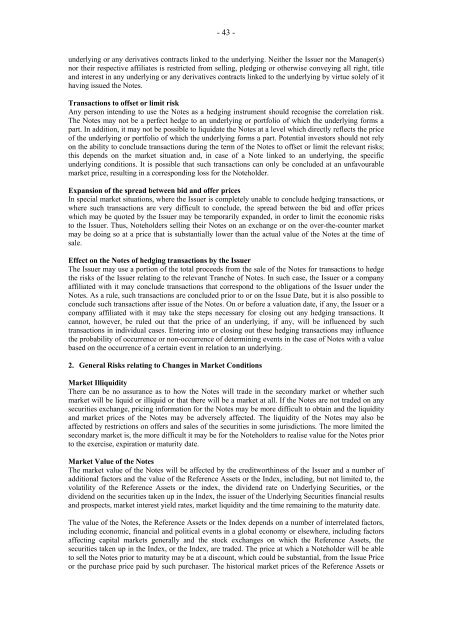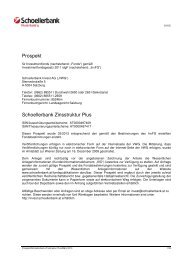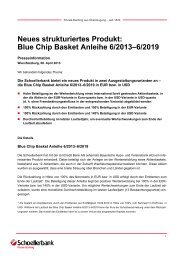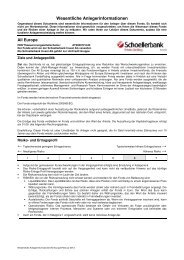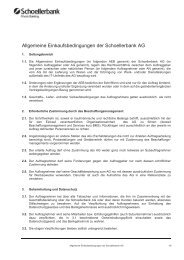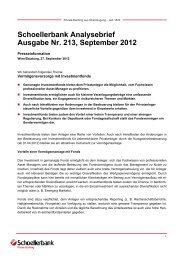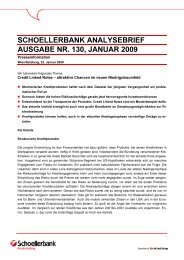BARCLAYS BANK PLC Barclays Capital
BARCLAYS BANK PLC Barclays Capital
BARCLAYS BANK PLC Barclays Capital
You also want an ePaper? Increase the reach of your titles
YUMPU automatically turns print PDFs into web optimized ePapers that Google loves.
- 43 -<br />
underlying or any derivatives contracts linked to the underlying. Neither the Issuer nor the Manager(s)<br />
nor their respective affiliates is restricted from selling, pledging or otherwise conveying all right, title<br />
and interest in any underlying or any derivatives contracts linked to the underlying by virtue solely of it<br />
having issued the Notes.<br />
Transactions to offset or limit risk<br />
Any person intending to use the Notes as a hedging instrument should recognise the correlation risk.<br />
The Notes may not be a perfect hedge to an underlying or portfolio of which the underlying forms a<br />
part. In addition, it may not be possible to liquidate the Notes at a level which directly reflects the price<br />
of the underlying or portfolio of which the underlying forms a part. Potential investors should not rely<br />
on the ability to conclude transactions during the term of the Notes to offset or limit the relevant risks;<br />
this depends on the market situation and, in case of a Note linked to an underlying, the specific<br />
underlying conditions. It is possible that such transactions can only be concluded at an unfavourable<br />
market price, resulting in a corresponding loss for the Noteholder.<br />
Expansion of the spread between bid and offer prices<br />
In special market situations, where the Issuer is completely unable to conclude hedging transactions, or<br />
where such transactions are very difficult to conclude, the spread between the bid and offer prices<br />
which may be quoted by the Issuer may be temporarily expanded, in order to limit the economic risks<br />
to the Issuer. Thus, Noteholders selling their Notes on an exchange or on the over-the-counter market<br />
may be doing so at a price that is substantially lower than the actual value of the Notes at the time of<br />
sale.<br />
Effect on the Notes of hedging transactions by the Issuer<br />
The Issuer may use a portion of the total proceeds from the sale of the Notes for transactions to hedge<br />
the risks of the Issuer relating to the relevant Tranche of Notes. In such case, the Issuer or a company<br />
affiliated with it may conclude transactions that correspond to the obligations of the Issuer under the<br />
Notes. As a rule, such transactions are concluded prior to or on the Issue Date, but it is also possible to<br />
conclude such transactions after issue of the Notes. On or before a valuation date, if any, the Issuer or a<br />
company affiliated with it may take the steps necessary for closing out any hedging transactions. It<br />
cannot, however, be ruled out that the price of an underlying, if any, will be influenced by such<br />
transactions in individual cases. Entering into or closing out these hedging transactions may influence<br />
the probability of occurrence or non-occurrence of determining events in the case of Notes with a value<br />
based on the occurrence of a certain event in relation to an underlying.<br />
2. General Risks relating to Changes in Market Conditions<br />
Market Illiquidity<br />
There can be no assurance as to how the Notes will trade in the secondary market or whether such<br />
market will be liquid or illiquid or that there will be a market at all. If the Notes are not traded on any<br />
securities exchange, pricing information for the Notes may be more difficult to obtain and the liquidity<br />
and market prices of the Notes may be adversely affected. The liquidity of the Notes may also be<br />
affected by restrictions on offers and sales of the securities in some jurisdictions. The more limited the<br />
secondary market is, the more difficult it may be for the Noteholders to realise value for the Notes prior<br />
to the exercise, expiration or maturity date.<br />
Market Value of the Notes<br />
The market value of the Notes will be affected by the creditworthiness of the Issuer and a number of<br />
additional factors and the value of the Reference Assets or the Index, including, but not limited to, the<br />
volatility of the Reference Assets or the index, the dividend rate on Underlying Securities, or the<br />
dividend on the securities taken up in the Index, the issuer of the Underlying Securities financial results<br />
and prospects, market interest yield rates, market liquidity and the time remaining to the maturity date.<br />
The value of the Notes, the Reference Assets or the Index depends on a number of interrelated factors,<br />
including economic, financial and political events in a global economy or elsewhere, including factors<br />
affecting capital markets generally and the stock exchanges on which the Reference Assets, the<br />
securities taken up in the Index, or the Index, are traded. The price at which a Noteholder will be able<br />
to sell the Notes prior to maturity may be at a discount, which could be substantial, from the Issue Price<br />
or the purchase price paid by such purchaser. The historical market prices of the Reference Assets or


